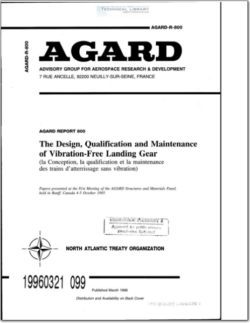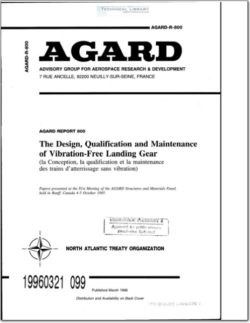AGARD-R-800

- Version
- 131 Downloads
- 18.95 MB File Size
- 1 File Count
- March 7, 2016 Create Date
- March 7, 2016 Last Updated
Vibration Free Landing Gear

Landing gear is an invaluable aircraft system, albeit
quite unpopular with most aircraft designers:
In extended position, it spoils the aerodynamic
shape of the aircraft. Retracted, it uses internal
space which "could much better have been devoted
to fuel or other useful things". Moreover, its dead
weight impairs flight performance. Looking at
landing gear from a structure point of view, it pro~
duces large concentrated loads and provides for a
lot of difficulties by requiring voluminous landing
gear bays and doors interrupting the smooth flow of
loads and stress. There is also the possibility that
the optimal position of the landing gear with regard
to e.g. nosewheel liftoff differs from that required
for a satisfactory behaviour as a ground vehicle, and
both positions might be unfavourable with regard to
structural attachment. Another stanza to this
lamentation could be devoted to the themes of
wheel size, brake accommodation, tyre size, tyre
mechanical characteristics, and tyre pressure.
Present author has spent almost thirty years of his
professional life in aircraft and landing gear design
and analysis. It appeared to him that to arrive at a
design satisfying straightforward and clearly written
physical requirements was hard enough. It was even
harder to defend such design from the particular
interests of other design disciplines. However, at
least in military landing gear performance and
design requirements the situation with regard to
"vibration—free" landing gear was even more
difficult. There was not only a lack of guidance with
regard to acceptable methods of design and
analysis, the requirement for a vibration-free
landing gear itself was compromised by accepting
“shimmy" to the extent that pilots could still control
the aircraft, that shimmy loads did not exceed
structural limits, and that the phenomenon was ade-
quately taken into account in fatigue analysis (see
for instance British requirements). What wonder
that budgets for shimmy analyses were limited at
best and that an analytical prediction of landing
gear shimmy was not considered a hard fact. Hence
the landing gear designer did not get much support
in striving for a landing gear free of shimmy,
especially not if this aspect would have led to
aircraft interface or even redesign problems.
| File | Action |
|---|---|
| AGARD-R-800 Vibration Free Landing Gear.pdf | Download |

Comment On This Post